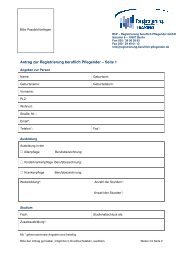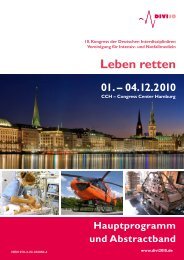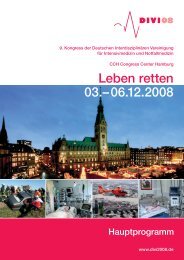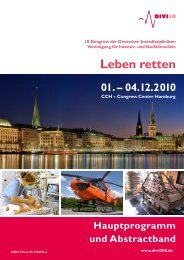Abstracts
Abstracts
Abstracts
Sie wollen auch ein ePaper? Erhöhen Sie die Reichweite Ihrer Titel.
YUMPU macht aus Druck-PDFs automatisch weboptimierte ePaper, die Google liebt.
<strong>Abstracts</strong><br />
DIVI2010 – POSTER<br />
dass die im klinischen Alltag beobachtete erhöhte Morbidität und<br />
Mortalität älterer Patienten eher nicht von einer eingeschränkten<br />
Immunkompetenz herrührt, sondern durch andere Faktoren, wie die im<br />
Alter gehäuften Komorbiditäten bedingt ist.<br />
P/07/07<br />
Influence of Drotrecogin Alpha (Activated) on Leptin<br />
mRNA Expression in an in vitro Inflammatory Model of<br />
Human Adipocytes<br />
T. Göksu 1 , M. Behnes 1 , J. Saur 1 , S. Lang 1 , M. Brueckmann 2 ,<br />
M. Borggrefe 1 , U. Hoffmann 1<br />
1 1st Medical Department, Medical Faculty Mannheim, University<br />
of Heidelberg, Mannheim, Deutschland, 2 Boehringer Ingelheim,<br />
Ingelheim, Deutschland<br />
Background: Leptin is an adipocyte-derived cytokine regulating energy<br />
homeostasis, metabolism as well as immune-inflammatory processes.<br />
Leptin also has thermogenic actions and regulates enzymes of fatty<br />
acid oxidation. Leptin is significantly increased in response to acute<br />
infection and sepsis and exerts direct effects on CD4+ T- lymphocyte<br />
proliferation, macrophage phagocytosis, and secretion of inflammatory<br />
cytokines such as IL-1 and tumor necrosis factor TNFα. We measured<br />
mRNA expression of leptin in cell cultures of differentiated human<br />
adipocytes after incubation with different concentrations of Drotrecogin<br />
alpha (activated) in an in vitro inflammatory model.<br />
Methods: We cultivated preadipocytes and differentiated them to<br />
adipocytes. Drotrecogin alpha (activated) was added in different<br />
concentrations (50ng/ml, 1µg/ml, 5µg/ml and 10µg/ml) and stimulated<br />
with TNFα (1ng/ml) for 6h and 24h. The mRNA steady-state expression<br />
of leptin was measured by real-time PCR and quantified by the<br />
comparative C T method using GAPDH as housekeeping gene.<br />
Results: Leptin mRNA levels decreased by 47% and 61% when<br />
stimulated with TNFα alone for 6h and 24h. After 6h incubation with<br />
TNFα together with increasing concentrations of Drotrecogin alpha<br />
(activated) (50ng/ml, 1µg/ml, 5µg/ml and 10µg/ml) mRNA levels of<br />
leptin did not change significantly (p>0.05), whereas after 24h mRNA<br />
levels of leptin increased by 27% (trend p=0.066).<br />
Conclusion: In an inflammatory model of human adipocytes incubation<br />
with Drotrecogin alpha (activated) for 24 h increased leptin mRNA<br />
expression in a dose dependent manner. Further in vitro and in vivo<br />
investigations are needed to confirm these findings and to reveal the<br />
role of Drotrecogin alpha (activated) in this context.<br />
80<br />
P/07/08<br />
Drotrecogin Alpha (Activated) Increases mRNA<br />
Expression of Adiponectin in Human Adipocytes Treated<br />
with TNF α in vitro<br />
U. Hoffmann 1 , M. Behnes 1 , T. Göksu 1 , S. Lang 1 , J. Saur 1 , M. Brueckmann 2 ,<br />
M. Borggrefe 1<br />
1 1st Medical Department, Medical Faculty Mannheim, University<br />
of Heidelberg, Mannheim, Deutschland, 2 Boehringer Ingelheim,<br />
Ingelheim, Deutschland<br />
Background: Adiponectin is a adipose-specific protein. In contrast to<br />
the markedly increased levels of many other adipocytokines, as leptin or<br />
TNFα, its level is reduced in obesity and type 2 diabetes. Adiponectin can<br />
induce the expression of anti-inflammatory cytokines such as IL-10 and<br />
IL-1 receptor antagonist in human monocytes and inhibits endothelial<br />
NF-kappa-B signalling through a cAMP-dependent pathway. A possible<br />
antiinflammatory effect of Drotrecogin alpha (activated) on adipocytes<br />
has not yet been demonstrated. We measured mRNA expression of<br />
adiponectin in cell cultures of differentiated human adipocytes after<br />
incubation with Drotrecogin alpha (activated) and addition of TNFα.<br />
Methods: Cultivated preadipocytes were differentiated to adipocytes.<br />
After incubation with Drotrecogin alpha (activated) in concentrations of<br />
50 ng/ml, 1 µg/ml, 5 µg/ml and 10 µg/ml and addition of TNFα (1ng/<br />
ml) for 6h and 24h, mRNA steady-state expression of adiponectin was<br />
measured by real-time PCR and quantified by the comparative C T<br />
method using GAPDH as housekeeping gene.<br />
Results: Adiponectin mRNA levels decreased significantly by 9%<br />
and 52% after incubation with TNFα alone for 6h and 24h. After 6h<br />
incubation with TNFα with increasing concentrations of Drotrecogin<br />
alpha (activated) mRNA levels of adiponectin showed no significant<br />
changes, whereas after 24h mRNA levels increased by 29% (trend<br />
p=0.034).<br />
Conclusion: Drotrecogin alpha (activated) increases Adiponectin<br />
mRNA expression of human adipocytes after 24h in an in vitro<br />
inflammatory model in a dose dependent way. This mechanism may<br />
indicate the anti-inflammatory response of adipocytes after treatment<br />
with Drotrecogin alpha (activated). Further in vitro and in vivo<br />
investigations are needed to confirm these findings.<br />
P/07/09<br />
Einfluss einer hoch-dosierten Selensubstitution auf<br />
die perioperative systemische Inflammation bei herzchirurgischen<br />
Eingriffen an der Herz-Lungen-Maschine<br />
C. Stoppe 1,2 , G. Schälte 1 , A. Wildenhues 1 , S. Metzelder 1 , A.K. Menon 3 ,<br />
R. Rossaint 1 , G. Marx 2 , S. Rex 1,2<br />
1 Universitätsklinikum Aachen, Klinik für Anästhesiologie, Aachen,<br />
Deutschland, 2 Universitätsklinikum Aachen, Fachübergreifende Klinik<br />
für Operative Intensivmedizin Erwachsene, Aachen, Deutschland,<br />
3 Universitätsklinikum Aachen, Klinik für Thorax-, Herz- und Gefäß-<br />
chirurgie, Aachen, Deutschland<br />
Einleitung: Vorangegangene Studien an kritisch kranken Patienten<br />
www.divi2010.de<br />
<strong>Abstracts</strong><br />
DIVI2010 – POSTER<br />
konnten bereits einen deutlichen Selenmangel nachweisen, welcher mit<br />
erhöhtem oxidativen Stress, der Entstehung eines Multiorganversagens<br />
und konsekutiv erhöhter Letalität verbunden war[2]. Patienten nach<br />
herzchirurgischen Eingriffen mit Herz-Lungen-Maschine(HLM) zeigen<br />
regelhaft das Bild eines systemischen Inflammations-Syndroms(SIRS),<br />
welches mit einem perioperativer Abfall des Selen-Spiegels verbunden<br />
ist[3].<br />
Fragestellung: Wir hypothetisierten, dass eine präventive präoperative<br />
Selensubstitution das Ausmaß eines postoperativen SIRS<br />
bei kardiochirurgischen Patienten verringern kann.<br />
Methoden: In dieser prospektiven Studie wurden 100 Patienten<br />
eingeschlossen, die sich einem herzchirurgischem Eingriff an der HLM<br />
unterzogen(mittleres Alter(±SD) 65±12J.;EuroScore:5,8±3,8). Nach<br />
Einleitung der Anästhesie erhielten alle Patienten 2000µg Natriumselenit<br />
i.v. sowie 1000µg Natriumselenit an jedem weiteren Tag auf der<br />
Intensivstation. Die Messung des Selengehalts im Vollblut erfolgte nach<br />
Einleitung, 4h nach Aufnahme auf die Intensivstation und an jedem<br />
weitern Morgen auf der Intensivstation vor erneuter Selensubstitution.<br />
Die statistische Analyse erfolgte mittels ANOVA.<br />
Ergebnisse: Unmittelbar präoperativ zeigte sich bei allen Patienten<br />
ein deutlicher Selenmangel mit Selenspiegeln unterhalb der<br />
europäischen Referenzwerte [Fig. 1A].Die präoperative Selengabe<br />
führte zunächst zu einem Ausgleich des Selendefizites, konnte jedoch<br />
den Selenabfall ab dem 1. postoperativen Tag nicht verhindern.<br />
Während des weiteren Verlaufs stabilisierten sich die Selenspiegel<br />
unter Fortführung des Substitutionsregimes. Im Vergleich mit einer<br />
historischen Kontrollgruppe ohne Selensubstitution konnte durch die<br />
perioperative Selensubstitution keine Verminderung der perioperativen<br />
Inflammation erreicht werden, wie der Verlauf des Serum-Procalcitonin-<br />
Spiegels zeigt[Fig. 1B].<br />
[Perioperativer Verlauf der Selenspiegel und PCT]<br />
Schlussfolgerung: Herzchirurgische Patienten zeigen trotz<br />
präoperativer hoch-dosierter Selensubstitution einen drastischen<br />
Selenabfall am 1.postoperativen Tag. Dies bietet eine mögliche<br />
Erklärung für die ausbleibende Abschwächung der postoperativen<br />
Entzündungsreaktion.<br />
www.divi2010.de<br />
P/07/10<br />
Humanes Angiotensin III zur Behandlung von<br />
Sepsislangzeitfolgen<br />
I. Niehaus 1<br />
1 Priv., Kronshagen, Deutschland<br />
Fragestellung: Untersuchung der Wirkung von dem Lipopolysaccharid<br />
bindendem Heptapeptid Angiotensin III (Ang III) zur Behandlung von<br />
Sepsisspätschäden anhand eines Fallberichtes.<br />
Methodik: µmol orale Dosen von Ang III werden zur Behandlung von<br />
neurologischen und mirkozirkulatorischen Sepsislangzeitschäden bei<br />
einer Pat. eingesetzt.<br />
Ergebnisse: Die erste orale Dosis von 0.1 mg (= 0.113 µmol ) Ang III<br />
verursachte keine Blutdruckänderung, aber eine verbesserte<br />
Durchblutung fühlbar durch Erwärmung zunächst in den Extremitäten,<br />
nach 1 Std. in den inneren Orangen verbunden mit einem muskelentspannenden<br />
Effekt. Nach 4 Std. normalisierte sich die Ruhepulsfrequenz<br />
auf 60-65 Schläge/min, vorher bestand seit der Sepsis von<br />
vor 15 Jahren Tachykardie mit einem Ruhepuls von 75-105 Schlägen/<br />
min. Nach 18 Std. zeigte sich eine bleibende Verbesserung der Motorik<br />
des linken Beines mit zurückkehrender Muskelkraft sowie verbesserte<br />
Feinmotorik, Seh- und Hörfähigkeit. Diese Effekte sind permanent.<br />
Schlussfolgerungen: Ang III wird in vivo gebildet aus Ang II durch<br />
die enzymatische Abspaltung von Asp am N-terminalen Ende. Ang<br />
III ist ein Heptapeptid mit der Aminosäuresequenz von Arg 1 -Val 2 -Tyr 3 -<br />
Ile 4 -His 5 -Pro 6 -Phe 7 . Arg 1 -His 5 stellt eine Lipopolysaccharid-bindende<br />
Pentapeptidsequenz dar gemäß dem Muster von B-H-P-H-B (B: Arg + ,<br />
Lys + , His + ; H: hydrophob; P: polar). Ang III bindet an Angiotensin II Typ<br />
1 (AT 1 -) und Typ 2 (AT 2 -)-Rezeptoren.<br />
LPS kann daher den Blutdruck steigernden Effekt von Ang II/III<br />
blockieren durch:<br />
1. Direkte Bindung an die Aminosäruen Arg 1 -His 5 von Ang II<br />
2. Bindung an die dritte intrazelluläre Schleife des AT1-Rezeptors mit<br />
Blockierung<br />
der Bindung des G-alpha-Proteins mit Verlust des intrazellulären<br />
Signaltransfers.<br />
[Angiotensinrezeptor]<br />
81






